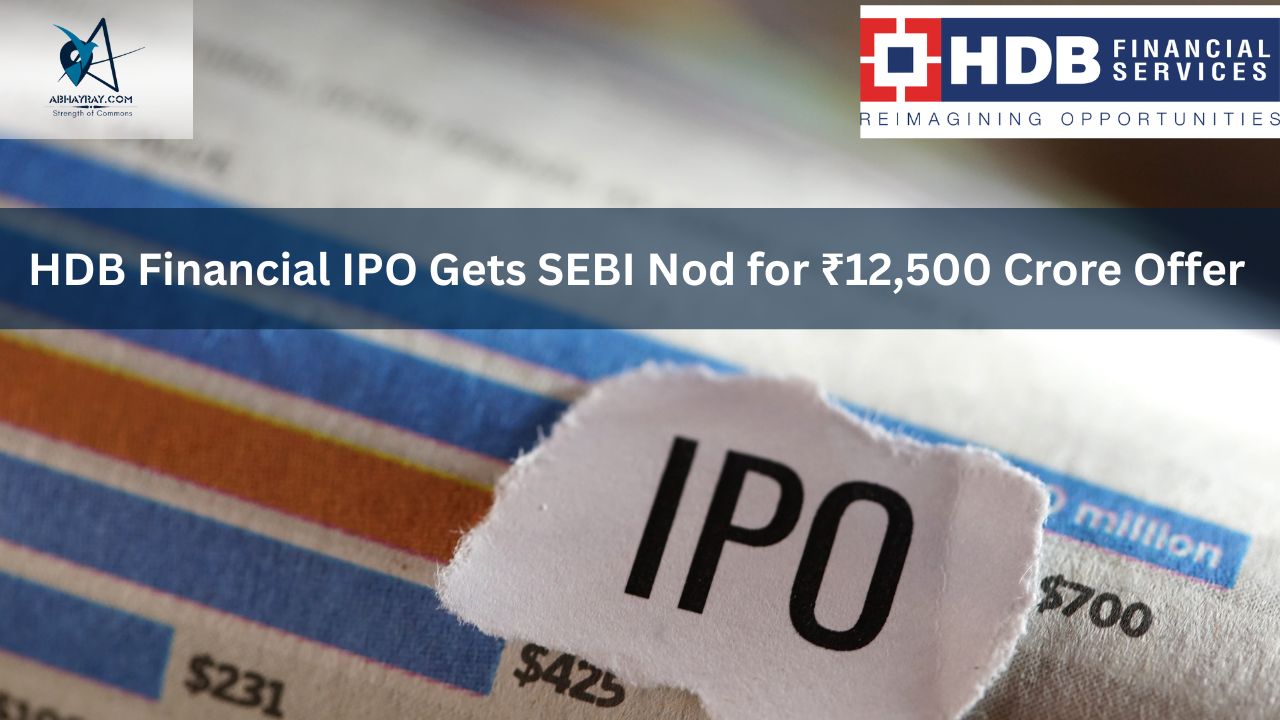Introduction
HDFC Bank subsidiary HDB Financial Services Ltd has received regulatory approval from the Securities and Exchange Board of India (Sebi) for its much-anticipated ₹12,500 crore initial public offering (IPO). The regulator also approved the IPOs of five other companies. The six IPOs together are slated to raise over ₹20,000 crore.
HDB Financial had earlier filed its draft red herring prospectus (DRHP), aiming to raise ₹2,500 crore through a fresh issue and ₹10,000 crore via offer for sale (OFS) by parent company HDFC Bank. This makes it one of the largest IPOs by a non-banking entity in the Indian capital market.
What is HDB Financial and its Business
The company founded in 2007 has evolved into one of the major non-deposit taking NBFCs in the country. As per the Reserve Bank of India (RBI), it is classified as an NBFC-Upper Layer (NBFC-UL), which means it is considered systemically important and must adhere to stricter regulatory norms than smaller peers.
Although, HDB Financial operates under the broader HDFC group umbrella, but it maintains a separate governance structure, complete with its own management, board, and risk controls. Looking at the company’s journey over the years, it has expanded its footprint across urban centres and smaller towns, with a lending portfolio that covers consumer loans, MSME financing, and asset-backed lending.
Key Services Provided
HDB Financial runs a multi-layered business that combines lending with business-process outsourcing work. Its lending programme is organised into three distinct streams.The first stream is Enterprise Lending, introduced in 2008. In this vertical HDB offers both secured and unsecured loans to micro, small and medium enterprises as well as select salaried professionals. Typical products include working-capital lines, equipment loans, and term funding for shop or office upgrades.
The second and third streams address very different borrowers. Asset Finance, launched in 2010, pays for new and used commercial vehicles, tractors and other income-generating equipment, giving transporters and contractors a way to purchase assets without tying up their own capital. Consumer Finance rounds out the portfolio with short-tenure loans for phones, appliances, two-wheelers and similar personal purchases.
Financial Performance
Over the past few years, HDB Financial Services has managed to grow steadily, especially during volatile economic cycles. Looking at the financial numbers of the company, as of September 30, 2024, the gross loan book stood at ₹98,620 crore, clocking a compound annual growth rate (CAGR) of 21% since FY22.
Furthermore, the total assets under management (AUM) of the company has reached ₹90,230 crore, and net profit for FY24 came in at ₹2,460.8 crore, up from ₹1,620 crore in FY22. The profitability metrics also showed a similar trend. The company recorded a return on assets (ROA) of 3.03% and a return on equity (ROE) of 19.55%. Its net interest margin (NIM) stood above 7. On the asset quality front, the company reported a gross non-performing asset (GNPA) ratio of 1.90% and a net NPA (NNPA) ratio of just 0.63%, supported by a provision coverage ratio (PCR) of 61%.
HDB Financial IPO: Market Position
HDB Financial Services has expanded its footprint across India with the focus on smaller cities and towns. A careful analysis reveals that the firm operated 1,772 branches spread over 1,162 cities and towns as of September 2024. This overall covers 31 states and union territories. Moreover, this network serves more than 17.5 million active customers. Furthermore, the company focuses on semi-urban and rural areas, with nearly 80% of its branches located outside the top 20 largest Indian cities.
HDB Objective of the Issue
The upcoming IPO of HDB Financial Services involves two primary components. First, it is a fresh issue of shares by the company itself and an Offer for Sale (OFS) by the promoter selling shareholder.
In simple understanding, the fresh issue is a major part of the company’s plan to raise new capital. On the flip side, the OFS involves existing shareholders selling a portion of their stake to the public.
HDB Risks involved
HDB Financial Services has outlined several risk factors in its DRHP. A key concern is the impact of broader economic conditions on the company’s performance.
As stated, “Any downturn in the macroeconomic environment in India could adversely affect our business, results of operations, cash flows and financial condition.”
Another significant risk involves the quality of the loan portfolio. The company’s gross Stage 3 loans, which indicate stressed or non-performing assets, have fluctuated over recent periods from 4.99% in March 2022 to 1.90% as of September 2024. The DRHP notes, “Non-payment or default by our customers, our inability to provide adequate provisioning coverage for non-performing assets or change in regulatorily mandated provisioning requirements may adversely affect our financial condition and results of operations.”
Conclusion
HDB Financial Services’ ₹12,500 crore IPO marks a major event in India’s capital markets, highlighting its strong financials and expanding reach. As a key NBFC under the HDFC umbrella, it offers diverse lending solutions across enterprise, asset, and consumer finance. With a compound annual loan growth of 21%, consistent profitability, and a wide rural-urban footprint, HDB is positioned for sustained growth. The fresh issue will infuse capital for future expansion, while the OFS provides an exit route for HDFC Bank. However, investors should carefully consider risks related to economic downturns and loan quality. The IPO reflects both opportunity and caution, making due diligence essential.
GMICapitals.com RaysVeda.com GetMyStartup.com LawCanal.com GetMyIndia.com ZinCob.com Angeltors.com

